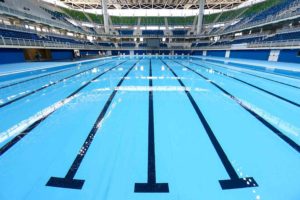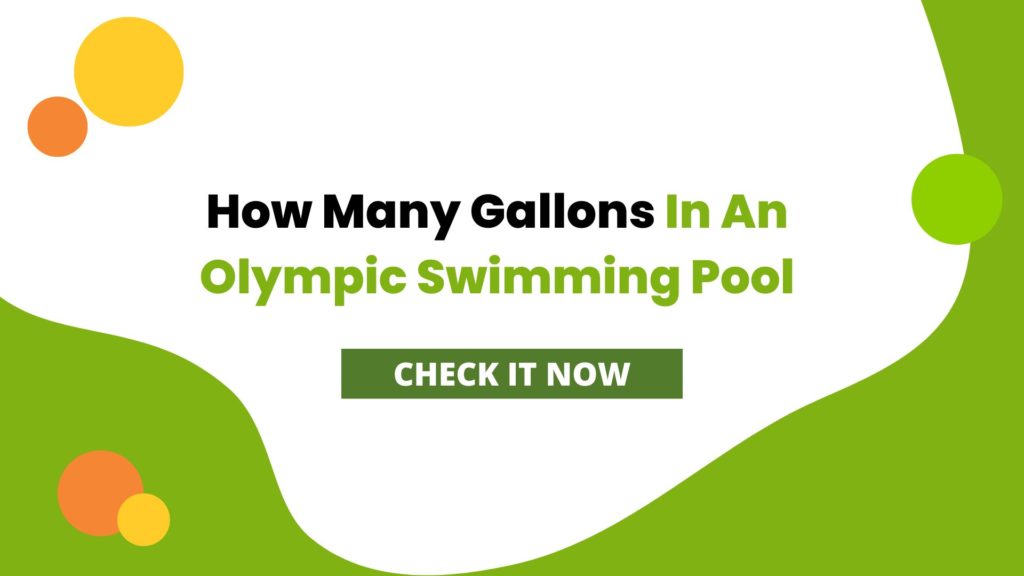Swimming has been an integral part of human culture for centuries, captivating our imaginations and challenging our physical abilities. And when it comes to the grandest stage of athletic competition, the Olympic Games, the world is witness to the extraordinary feats performed within the vast expanse of Olympic swimming pools. But have you ever wondered about the sheer volume of water required to fill such an iconic symbol of aquatic excellence?
In this article, we will dive into the answer to the captivating question: How Many Gallons In An Olympic Swimming Pool? Also we have covered what is Olympic swimming pool and their Sizes so lets move forword.
Table of Contents
ToggleWhat are Olympic swimming pools?
Olympic swimming pools are specially designed aquatic facilities that adhere to strict standards and regulations set by the International Olympic Committee (IOC). These pools serve as the primary venues for swimming competitions during the Olympic Games, showcasing the world’s best swimmers as they compete for gold, silver, and bronze medals.
Olympic swimming pools are built with precision to ensure fairness and optimal conditions for athletes. They are typically constructed using concrete or stainless steel materials and feature a rectangular shape.
The dimensions of an Olympic swimming pool vary depending on the specific event it is intended for, such as freestyle, backstroke, breaststroke, butterfly, or individual medley races.
Different Sizes:
The most common size for an Olympic swimming pool is 50 meters in length, 25 meters in width, and at least 2 meters in depth. However, there are also Olympic-sized pools that are 50 meters long but wider than the standard 25 meters, allowing for multiple lanes and accommodating more swimmers in events like relays.
The pool’s depth gradually slopes from the shallow end to the deep end, providing a suitable environment for swimmers to start, turn, and swim efficiently.
Features:
Olympic swimming pools are equipped with various additional features, including starting blocks for race takeoffs, lane markers to guide swimmers, and electronic timing systems to record accurate race times. Additionally, some Olympic swimming pools may include specialized areas for diving platforms and synchronized swimming events.
Different Types of Olympic Swimming Pools:
There are primarily two types of Olympic swimming pools: indoor and outdoor. Each type has its own characteristics and considerations.
1. Indoor Olympic Swimming Pools:
- These pools are enclosed within a structure, providing a controlled environment regardless of external weather conditions.
- Indoor pools often feature advanced climate control systems to maintain optimal air and water temperatures.
- The structure surrounding the pool may include seating areas, spectator stands, and other facilities to accommodate large audiences.
- Indoor pools offer advantages such as protection from adverse weather, consistent lighting conditions, and reduced external factors that could affect performance.
2. Outdoor Olympic Swimming Pools:
- These pools are exposed to the elements and are typically located in open-air venues.
- Outdoor pools offer a unique swimming experience with natural lighting and potentially scenic surroundings.
- They may require additional measures to manage temperature fluctuations, sun exposure, and weather-related challenges.
- Outdoor pools often have larger seating capacities to accommodate larger crowds during major events.
It’s important to note that both indoor and outdoor Olympic swimming pools must meet the strict standards and specifications set by the International Swimming Federation (FINA) and the International Olympic Committee (IOC) to ensure fairness, safety, and optimal conditions for athletes.

How Many Gallons In An Olympic Swimming Pool
The number of gallons in an Olympic swimming pool depends on the pool’s dimensions and depth, as there are variations in pool sizes used for Olympic events.
For a standard Olympic-sized swimming pool with dimensions of 50 meters in length, 25 meters in width, and a minimum depth of 2 meters, the approximate volume is 2,500,000 liters or 660,430 gallons.
It’s important to note that the actual volume can vary depending on factors such as the exact dimensions, the specific shape of the pool, and any additional features it may have.
Therefore, it is recommended to consult the precise measurements of a particular Olympic swimming pool to obtain an accurate calculation of its volume in gallons.
Calculating the Volume of an Olympic Swimming Pool
Calculating the volume of an Olympic swimming pool requires taking into account its length, width, and average depth. By following the appropriate formula and unit conversions, we can accurately determine the volume of water that fills these impressive aquatic arenas.
1. Determine the Measurements:
- Length: Measure the distance from one end of the pool to the other, typically in meters.
- Width: Measure the width of the pool, which is usually consistent throughout its length, also in meters.
- Average Depth: Measure the depth of the pool at various points and calculate the average depth, generally in meters.
- Use the formula:
The volume of a rectangular swimming pool can be calculated using the formula: Volume = Length x Width x Average Depth - Convert the volume to gallons:
Since gallons are a commonly used unit of measurement for water volume, it is helpful to convert the volume from cubic meters to gallons. The conversion factor to convert cubic meters to gallons is approximately 264.172.
Volume (in gallons) = Volume (in cubic meters) x 264.172
Example calculation:
Let’s consider an Olympic swimming pool with a length of 50 meters, a width of 25 meters, and an average depth of 2.5 meters.
Volume = 50 m x 25 m x 2.5 m Volume = 3,125 cubic meters
Volume (in gallons) = 3,125 cubic meters x 264.172 Volume (in gallons) ≈ 826,527 gallons
Therefore, in this example, the volume of water required to fill the Olympic swimming pool would be approximately 826,527 gallons.
By following these steps, we can accurately calculate the volume of any Olympic swimming pool and gain a better understanding of the vast quantities of water they contain.
The Vast Quantities Within an Olympic Swimming Pool
Once we have calculated the volume of an Olympic swimming pool in cubic meters, it’s fascinating to convert it into gallons to grasp the immense quantities of water that fill these remarkable aquatic arenas. Using gallons as a unit of measurement allows us to better comprehend the scale and magnitude of these bodies of water.
To put the volume of an Olympic swimming pool into perspective, consider the following comparative examples:
2. Equivalent Number of Standard Swimming Pools:
The average residential swimming pool typically holds around 20,000 gallons of water. By dividing the volume of the Olympic swimming pool by this average, we can determine how many standard swimming pools would be needed to hold the same amount of water. The result is usually staggering, highlighting just how massive Olympic swimming pools truly are.
2. Number of Water Bottles Needed:
Another relatable comparison is to determine the number of water bottles required to fill an Olympic swimming pool. Considering that a standard water bottle typically holds around 16 fluid ounces (or 0.125 gallons), we can divide the volume of the pool by this value to obtain an estimate of the number of water bottles needed. This calculation serves as a tangible representation of the sheer quantity of water present in these pools.
3. Water Usage Comparisons:
Understanding the water usage of an Olympic swimming pool can provide additional context. For instance, the average household in the United States uses approximately 300 gallons of water per day. By comparing this value to the volume of an Olympic swimming pool, we can gain insight into the enormous water requirements necessary to fill and maintain these pools.
Conclusion:
In conclusion, the volume of water contained within an Olympic swimming pool reveals the immense scale and significance of these iconic structures. They symbolize athletic excellence, inspire athletes, and captivate audiences worldwide.
With unique features such as diving platforms, synchronized swimming areas, and precise lane markers, Olympic swimming pools cater to the needs of various disciplines, ensuring fair competition. The pools prioritize water quality through advanced filtration systems, chemical treatments, and temperature control, creating a safe environment for athletes to showcase their skills.
Read More

